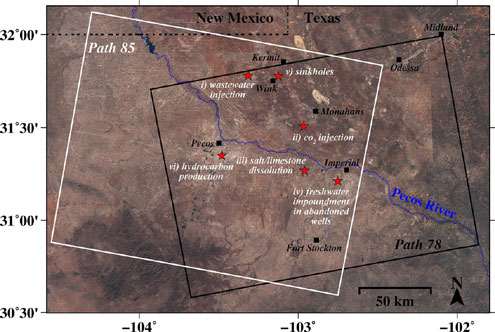That’s the finding of a geophysical team from Southern Methodist University, Dallas that previously reported the rapid rate at which the sinkholes are expanding and new ones forming.
Now the team has discovered that various locations in large portions of four Texas counties are also sinking and uplifting.
Radar satellite images show significant movement of the ground at localities in a 4000-square-mile area — in one place as much as 40 inches over the past two-and-a-half years, say the geophysicists.
“The ground movement we’re seeing is not normal. The ground doesn’t typically do this without some cause,” said geophysicist Zhong Lu, a professor in the Roy M. Huffington Department of Earth Sciences at SMU and a global expert in satellite radar imagery analysis.
“These hazards represent a danger to residents, roads, railroads, levees, dams, and oil and gas pipelines, as well as potential pollution of ground water,” Lu said. “Proactive, continuous detailed monitoring from space is critical to secure the safety of people and property.”
The scientists made the discovery with analysis of medium-resolution (15 feet to 65 feet) radar imagery taken between November 2014 and April 2017. The images cover portions of four oil-patch counties where there’s heavy production of hydrocarbons from the oil-rich West Texas Permian Basin.
The imagery, coupled with oil-well production data from the Texas Railroad Commission, suggests the area’s unstable ground is associated with decades of oil activity and its effect on rocks below the surface of the earth.

The SMU researchers caution that ground movement may extend beyond what radar observed in the four-county area. The entire region is highly vulnerable to human activity due to its geology — water-soluble salt and limestone formations, and shale formations.
“Our analysis looked at just this 4000-square-mile area,” said study co-author and research scientist Jin-Woo Kim, a research scientist in the SMU Department of Earth Sciences.
“We’re fairly certain that when we look further, and we are, that we’ll find there’s ground movement even beyond that,” Kim said. “This region of Texas has been punctured like a pin cushion with oil wells and injection wells since the 1940s and our findings associate that activity with ground movement.”
Lu, Shuler-Foscue Chair at SMU, and Kim reported their findings in the Nature publication Scientific Reports, in the article “Association between localized geohazards in West Texas and human activities, recognized by Sentinel-1A/B satellite radar imagery.”
The researchers analyzed satellite radar images that were made public by the European Space Agency, and supplemented that with oil activity data from the Texas Railroad Commission.
The study is among the first of its kind to identify small-scale deformation signals over a vast region by drawing from big data sets spanning a number of years and then adding supplementary information.
The research is supported by the NASA Earth Surface and Interior Program, and the Shuler-Foscue Endowment at SMU.
Imagery captures changes that might otherwise go undetected
The SMU geophysicists focused their analysis on small, localized, rapidly developing hazardous ground movements in portions of Winkler, Ward, Reeves and Pecos counties, an area nearly the size of Connecticut. The study area includes the towns of Pecos, Monahans, Fort Stockton, Imperial, Wink and Kermit.
The images from the European Space Agency are the result of satellite radar interferometry from recently launched open-source orbiting satellites that make radar images freely available to the public.
With interferometric synthetic aperture radar, or InSAR for short, the satellites allow scientists to detect changes that aren’t visible to the naked eye and that might otherwise go undetected.
The satellite technology can capture ground deformation with an accuracy of sub-inches or better, at a spatial resolution of a few yards or better over thousands of miles, say the researchers.
Ground movement associated with oil activity
The SMU researchers found a significant relationship between ground movement and oil activities that include pressurized fluid injection into the region’s geologically unstable rock formations.
Fluid injection includes waste saltwater injection into nearby wells, and carbon dioxide flooding of depleting reservoirs to stimulate oil recovery.
Injected fluids increase the pore pressure in the rocks, and the release of the stress is followed by ground uplift. The researchers found that ground movement coincided with nearby sequences of wastewater injection rates and volume and CO2 injection in nearby wells.
Also related to the ground’s sinking and upheaval are dissolving salt formations due to freshwater leaking into abandoned underground oil facilities, as well as the extraction of oil.
“Movements around the roads and oil facilities to the southwest of Imperial, Texas, should be thoroughly monitored to mitigate potential catastrophes,” the researchers write in the study.
About 5.5 miles south of Pecos, their radar analysis detected more than 1 inch of subsidence near new wells drilled via hydraulic fracturing and in production since early 2015. There have also been six small earthquakes recorded there in recent years, suggesting the deformation of the ground generated accumulated stress and caused existing faults to slip.
“We have seen a surge of seismic activity around Pecos in the last five to six years. Before 2012, earthquakes had not been recorded there. At the same time, our results clearly indicate that ground deformation near Pecos is occurring,” Kim said. “Although earthquakes and surface subsidence could be coincidence, we cannot exclude the possibility that these earthquakes were induced by hydrocarbon production activities.”
For more details and high-resolution downloadable images of the findings, visit http://bit.ly/2ptNE6W